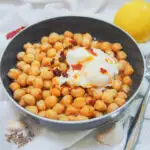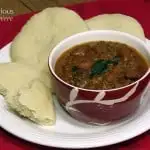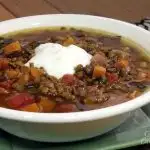Pae Hin is a Burmese chickpea soup that uses split chickpeas and rice noodles to create a rich and warming soup perfect for a cold winter day.
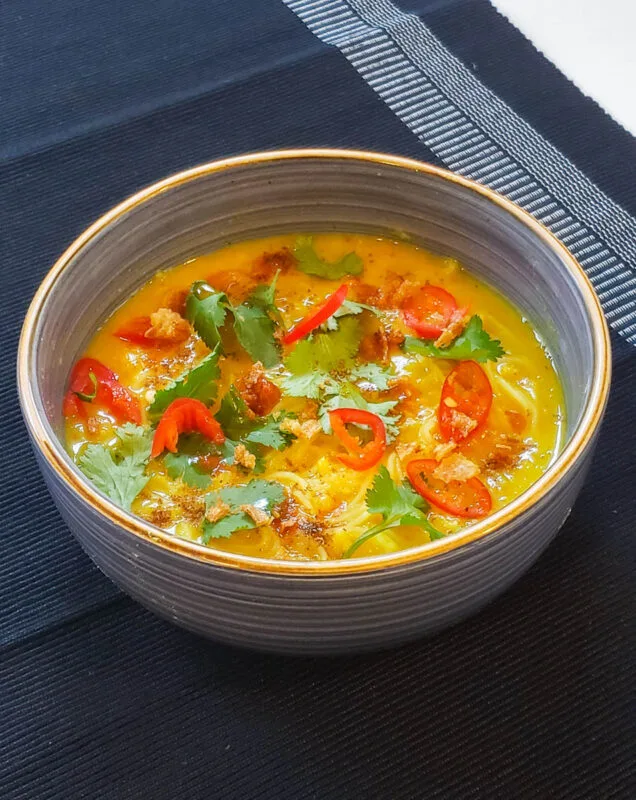
A Burmese Soup That Will Keep You Warm During Winter
Growing up in Israel, I’ve always had a hard time going through winter.
Indeed, Middle Eastern winter is relatively mild and the countryside is lush and green. But I always missed the sun, couldn’t stand the winds, and was cold every night, as we never had a proper heating system at home.
Yet, after moving to the Netherlands, I have learned to miss the Levantine half-cloudy-half-sunny winter months. The cold season in Western Europe was a complete shock to me, and I still have a hard time dealing with it. Nevertheless, I have developed some sophisticated and delicious methods to survive days of harsh weather.
The dish that I’ll be sharing with you here has been a winter staple of mine for two years already. Aside from being extremely comforting, it offers a great vegetarian source of protein and tells us a fascinating and ancient story of cultural interaction and ethnic diversity.
Learning Myanmar cuisine in a Vietnamese restaurant
In 2022, I started cooking in a Vietnamese restaurant in Amsterdam. After working at a Thai restaurant in Israel and falling in love with this Southeast Asian cuisine, I was curious to learn what Vietnam has to offer.
On my first shift, I was introduced to the kitchen staff. I asked everyone for their names, as well as what part of Vietnam are they from. The owner laughed.
“They’re all from Myanmar”, he said.
‘What kind of Vietnamese restaurant is this?’ I thought to myself. I was confused and felt a bit cheated.
As the hours went by, lunchtime arrived and Zhagoum, the head chef, prepared a meal for the whole staff.
Starving, I was served a plate of roasted chicken with rice and a side bowl of yellow, “gooey” soup, which seemed to have been made out of lentils.
The soup was everything that I needed at the moment. Not only was it boiling hot, but it was also creamy, filling, and with the right amount of spice.
When I asked about the soup, Zhagoum replied that it is a traditional Myanmar soup, made of split chickpeas (which I had never heard of) and spices.
Thus, every shift in the restaurant, I got to learn something new about Myanmar’s culture, ethnic diversity (Zhagoum wasn’t even Burmese, but from the Kachin minority group), and its unique cuisine.
During my time there, Zhagoum taught me his own recipe for the soup. However, he also stated that his version is not 100% “authentic”, due to the lack of some ingredients and his personal preferences. (Zhagoum, for example, preferred to add meat to the soup, while the traditional version is usually vegetarian.)

Finding the chickpea soup
After traveling to various border areas in Thailand and Cambodia, where Burmese, Shan, and other Myanmar ethnic groups reside, I have encountered not only the same comforting soup, but also other similar yellowish and “gooey” delicacies.
It seemed to be a recurring theme in Myanmar’s cuisine, and I have gradually become determined to understand what I’m eating and how Zhagoum’s magic soup fits in.
Indian food in Myanmar
Since ancient times, Myanmar has been absorbing cultural, lingual, theological, and gastronomic influences from the Indian subcontinent. Even though Burmese Indians make up less than 5% of Myanmar’s population, the country’s main religion, literature, and some of its most favored street food delicacies are of Indian origin.
Furthermore, the extensive use of turmeric powder and the popularity of legumes such as chickpeas and lentils in Myanmar’s cuisine also indicate India’s deep cultural influence.
In fact, the main body of today’s dish indeed consists of split chickpeas. Those are popular all around Myanmar. And they are also widely consumed in the Indian subcontinent, known there as “chana dal” or “Bengal gram dal”. In the Burmese language, they are generally referred to as “Indian peas”.
What are split chickpeas?
Split chickpeas are chickpeas that are first hulled and then split in two. Because of this, the cooking process is significantly faster than the whole version. And, they more easily dissolve in soups and stews.
You can find split chickpeas online (affiliate link).
In Myanmar cuisine, split chickpeas are used in various ways. They can be dried and ground into flour. You will also find them used to make tofu. They are also served as a nutritious and effective thickening agent in soups gravies.
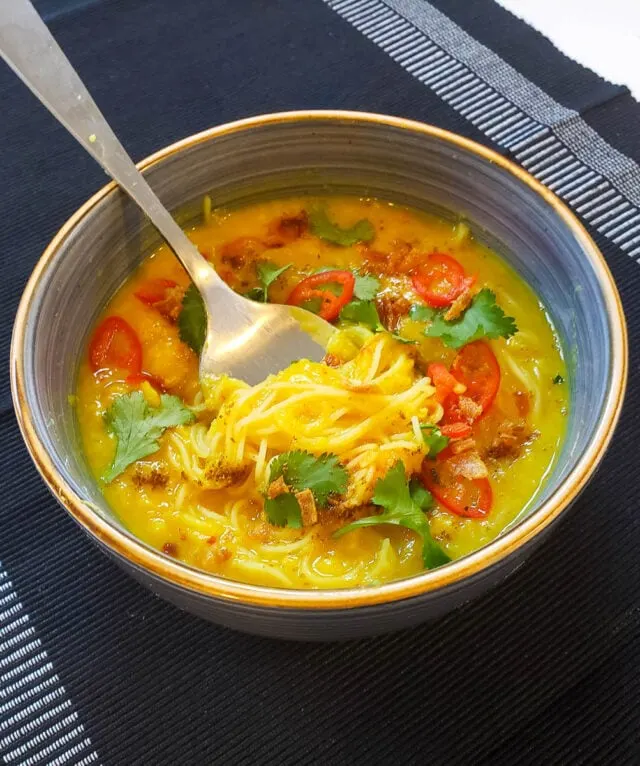
Split chickpea soup
The dish’s name, “Pae Hin”, literally translates to “peas soup”.
Split chickpeas are most commonly used, however, they can be substituted with red lentils, yellow lentils, or split peas.
To make the soup you soak the peas and cook them with aromatics like onions and turmeric powder (which intensifies the legume’s yellow color).
Towards the end of cooking you add rice vermicelli (affiliate link) (a non-Indian twist, more unique to the region). These contribute an additional textural dimension to the dish.
The last component of the dish, the tadka, is what makes this dish so flavorful.
What is tadka?
Tadka is a spiced oil commonly used in Indian cooking.
To make it, spices and aromatics are sautéed in oil or clarified butter. This infuses the oil with the favor of the spices.
The oil is poured hot into the main soup pot and mixed into the soup, enhancing its flavors.
It is important to use a sufficient amount of oil when sauteing the spices, as it helps them to release their essential oils.
Enjoy this winter chickpea soup
Pae Hin is relatively quick and easy to make. It is highly nutritious and can last in a fridge for quite some time.
In fact, Zhagoum claims that after the soup sets in the fridge for a day or two, the flavors ripen and deepen even more.
But, don’t take his word for it. Try for yourselves, and let us know if the magic is there!
Pae Hin (Burmese Chickpea Soup)
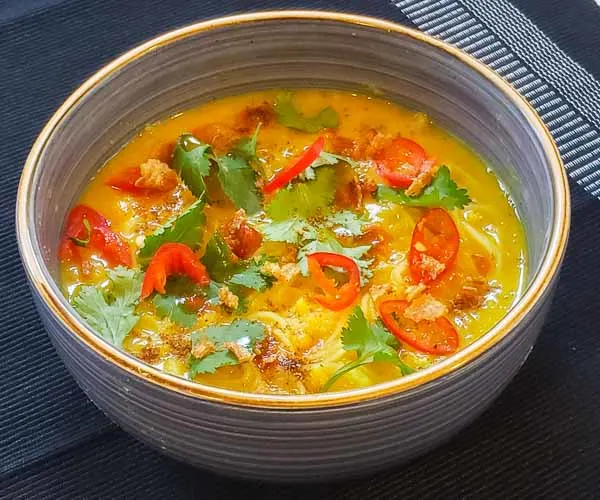
Pae Hin is a Burmese chickpea soup that uses split chickpeas and rice noodles to create a rich and warming soup perfect for a cold winter day.
Ingredients
- 2 cups split chickpeas, soaked overnight*
- 1 tsp turmeric powder
- 2 tsp salt
- 1/2 medium white onion, diced
- 2 garlic cloves, minced
- 7-8 cups of water (more if needed)
- 50 g (approx 2 oz) rice vermicelli
For the tadka
- 1/3 cup vegetable oil
- 1/2 medium white onion, diced
- 4 garlic cloves, slightly crushed
- 1 thumb-sized piece of ginger, minced
- 1/2 tsp turmeric powder
- 1 tsp chili powder
- 1 tsp Burmese masala powder**
To garnish
- Cilantro
- A sprinkle of masala powder
- Fried onions (reserved from making the tadka)
Instructions
For the soup
- Boil split chickpeas, turmeric powder, salt, white onion, and garlic with 7-8 cups of water.
- Cook for 15-20 minutes, until the split chickpeas are thoroughly cooked.
- Add dried rice vermicelli to the pot and cook for another 5 minutes, until the noodles are soft (but not overcooked).
While the soup is cooking, make the tadka
- Heat 1/3 cup of vegetable oil in a frying pan and add the chopped onion. Sauté on low to medium heat until golden brown. Remove a small quantity of the fried onion, and place it in a bowl to use later as a garnish, before moving to the next step.
- Add the garlic and ginger and sauté for another minute.
- Add turmeric powder, chili powder, and Burmese masala powder, sauté for another 30 seconds.
Finishing it off
- Pour the tadka into the pot of soup and give everything a gentle mix.
- Transfer into serving bowls, garnish with cilantro, a sprinkle of masala powder, and fried onions.*** Enjoy!
Notes
* Split chickpeas can be found in Indian grocery stores, but can be substituted with red lentils, yellow lentils, or split peas, if desired.
** Burmese masala powder can be substituted with Indian garam masala powder.
*** The soup may be served as a main dish by itself, with rice, or with flatbread, such as roti or paratha. It can also be served as a side dish as a part of a larger meal.
Recommended Products
As an Amazon Associate and member of other affiliate programs, We earn from qualifying purchases.
Nutrition Information:
Yield:
4Serving Size:
1/4 of recipeAmount Per Serving: Calories: 341
If you liked this recipe, here are some similar dishes you may enjoy!




